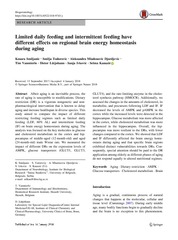Приказ основних података о документу
Limited daily feeding and intermittent feeding have different effects on regional brain energy homeostasis during aging.
| dc.creator | Smiljanić, Kosara | |
| dc.creator | Todorović, Smilja | |
| dc.creator | Mladenović, Aleksandra | |
| dc.creator | Vanmierlo, Tim | |
| dc.creator | Lütjohann, Dieter | |
| dc.creator | Ivković, Sanja | |
| dc.creator | Kanazir, Selma | |
| dc.date | 2019-01-16 | |
| dc.date.accessioned | 2018-01-24T13:02:09Z | |
| dc.date.available | 2019-01-16 | |
| dc.date.issued | 2018 | |
| dc.identifier.issn | 1389-5729 | |
| dc.identifier.uri | http://link.springer.com/10.1007/s10522-018-9743-y | |
| dc.identifier.uri | http://www.ncbi.nlm.nih.gov/pubmed/29340834 | |
| dc.identifier.uri | https://radar.ibiss.bg.ac.rs/handle/123456789/2960 | |
| dc.description.abstract | Albeit aging is an inevitable process, the rate of aging is susceptible to modifications. Dietary restriction (DR) is a vigorous nongenetic and nonpharmacological intervention that is known to delay aging and increase healthspan in diverse species. This study aimed to compare the impact of different restricting feeding regimes such as limited daily feeding (LDF, 60% AL) and intermittent feeding (IF) on brain energy homeostasis during aging. The analysis was focused on the key molecules in glucose and cholesterol metabolism in the cortex and hippocampus of middle-aged (12-month-old) and aged (24-month-old) male Wistar rats. We measured the impact of different DRs on the expression levels of AMPK, glucose transporters (GLUT1, GLUT3, GLUT4), and the rate-limiting enzyme in the cholesterol synthesis pathway (HMGCR). Additionally, we assessed the changes in the amounts of cholesterol, its metabolite, and precursors following LDF and IF. IF decreased the levels of AMPK and pAMPK in the cortex while the increased levels were detected in the hippocampus. Glucose metabolism was more affected in the cortex, while cholesterol metabolism was more influenced in the hippocampus. Overall, the hippocampus was more resilient to the DRs, with fewer changes compared to the cortex. We showed that LDF and IF differently affected the brain energy homeostasis during aging and that specific brain regions exhibited distinct vulnerabilities towards DRs. Consequently, special attention should be paid to the DR application among elderly as different phases of aging do not respond equally to altered nutritional regimes. | en |
| dc.relation | info:eu-repo/grantAgreement/MESTD/Basic Research (BR or ON)/173056/RS// | |
| dc.relation | Fogarty International Research Award, NIH (R03AG046216) | |
| dc.rights | embargoedAccess | |
| dc.source | Biogerontology | |
| dc.subject | AMPK | |
| dc.subject | Aging | |
| dc.subject | Brain | |
| dc.subject | Cholesterol metabolism | |
| dc.subject | Dietary restriction | |
| dc.subject | Glucose transporters | |
| dc.title | Limited daily feeding and intermittent feeding have different effects on regional brain energy homeostasis during aging. | en |
| dc.type | article | en |
| dc.rights.license | ARR | |
| dcterms.abstract | Ивковић, Сања; Смиљанић, Косара; Тодоровић, Смиља; Младеновић Ђорђевић, Aлександра; Ванмиерло, Тим; Лüтјоханн, Диетер; Каназир, Селма; | |
| dc.rights.holder | © Springer Science+Business Media B.V., part of Springer Nature 2018 | |
| dc.citation.issue | 2 | |
| dc.citation.volume | 19 | |
| dc.identifier.doi | 10.1007/s10522-018-9743-y | |
| dc.identifier.pmid | 29340834 | |
| dc.identifier.scopus | 2-s2.0-85040581502 | |
| dc.identifier.wos | 000426660600002 | |
| dc.citation.apa | Smiljanic, K., Todorovic, S., Mladenovic Djordjevic, A., Vanmierlo, T., Lütjohann, D., Ivkovic, S., & Kanazir, S. (2018). Limited daily feeding and intermittent feeding have different effects on regional brain energy homeostasis during aging. Biogerontology, DOI:10.1007/s10522-018-9743-y. | |
| dc.citation.vancouver | Smiljanic K, Todorovic S, Mladenovic Djordjevic A, Vanmierlo T, Lütjohann D, Ivkovic S, Kanazir S. Limited daily feeding and intermittent feeding have different effects on regional brain energy homeostasis during aging. Biogerontology. 2018;DOI:10.1007/s10522-018-9743-y. | |
| dc.citation.spage | 121 | |
| dc.citation.epage | 132 | |
| dc.type.version | publishedVersion | |
| dc.identifier.fulltext | https://radar.ibiss.bg.ac.rs/bitstream/id/4074/Biogerontology_2018.pdf | |
| dc.citation.rank | M21 |

